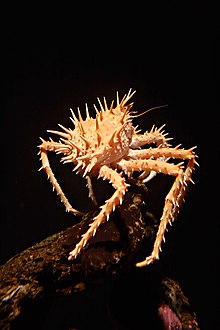| King crabs Temporal range:
| |
|---|---|

| |
| Paralithodes californiensis | |
| Scientific classification | |
| Domain: | Eukaryota |
| Kingdom: | Animalia |
| Phylum: | Arthropoda |
| Class: | Malacostraca |
| Order: | Decapoda |
| Suborder: | Pleocyemata |
| (unranked): | Reptantia |
| Infraorder: | Anomura |
| Superfamily: | Paguroidea Samouelle, 1819 |
| Family: | Lithodidae Samouelle, 1819 |
| Genera[1] | |
|
Hapalogastrinae Brandt, 1850
Lithodinae Samouelle, 1819
| |
King crabs are decapod crustaceans of the family Lithodidae[b] that are chiefly found in deep waters and are adapted to cold environments.[2][3] They are composed of two subfamilies: Lithodinae, which tend to inhabit deep waters, are globally distributed, and comprise the majority of the family's species diversity;[3][4] and Hapalogastrinae, which are endemic to the North Pacific and inhabit exclusively shallow waters.[3] King crabs superficially resemble true crabs but are generally understood to be closest to the pagurid hermit crabs.[2][4][5] This placement of king crabs among the hermit crabs is supported by several anatomical peculiarities which are present only in king crabs and hermit crabs.[6] Although some doubt still exists about this hypothesis, king crabs are the most widely quoted example of carcinisation among decapods.[6] Several species of king crabs, especially in Alaskan and southern South American waters, are targeted by commercial fisheries and have been subject to overfishing.[2][7][8]
Cite error: There are <ref group=lower-alpha> tags or {{efn}} templates on this page, but the references will not show without a {{reflist|group=lower-alpha}} template or {{notelist}} template (see the help page).
- ^ De Grave, Sammy; Pentcheff, N. Dean; Ahyong, Shane T.; et al. (2009). "A classification of living and fossil genera of decapod crustaceans" (PDF). The Raffles Bulletin of Zoology. Suppl. 21: 1–109. Archived from the original (PDF) on 2011-06-06.
- ^ a b c d Poore, Gary C. B.; Ahyong, Shane T. (2023). "Anomura". Marine Decapod Crustacea: A Guide to Families and Genera of the World. CRC Press. pp. 311–317. ISBN 978-1-4863-1178-1.
- ^ a b c Hall, Sally; Thatje, Sven (October 2009). "Global bottlenecks in the distribution of marine Crustacea: temperature constraints in the family Lithodidae" (PDF). Journal of Biogeography. 36 (11): 2125–2135. Bibcode:2009JBiog..36.2125H. doi:10.1111/j.1365-2699.2009.02153.x. Archived (PDF) from the original on 29 May 2023.
- ^ a b Noever, Christoph; Glenner, Henrik (2017-07-05). "The origin of king crabs: hermit crab ancestry under the magnifying glass" (PDF). Zoological Journal of the Linnean Society. 182 (2): 300–318. doi:10.1093/zoolinnean/zlx033. Archived (PDF) from the original on 2019-07-16 – via the University of Copenhagen.
- ^ Cite error: The named reference
Ahyong 2010was invoked but never defined (see the help page). - ^ a b Keiler, Jonas; Richter, Stefan; Wirkner, Christian S. (2013-03-19). "Evolutionary morphology of the hemolymph vascular system in hermit and king crabs (Crustacea: Decapoda: Anomala)". Journal of Morphology. 274 (7): 759–778. doi:10.1002/jmor.20133. PMID 23508935. S2CID 24458262.
- ^ Dvoretsky, Alexander G.; Dvoretsky, Vladimir G. (November 2017). "Red king crab (Paralithodes camtschaticus) fisheries in Russian waters: historical review and present status". Reviews in Fish Biology and Fisheries. 28 (2): 331–353. doi:10.1007/s11160-017-9510-1. ISSN 0960-3166.
- ^ Cite error: The named reference
Klaus et al. 2004was invoked but never defined (see the help page).